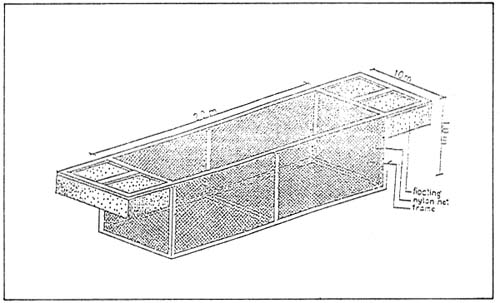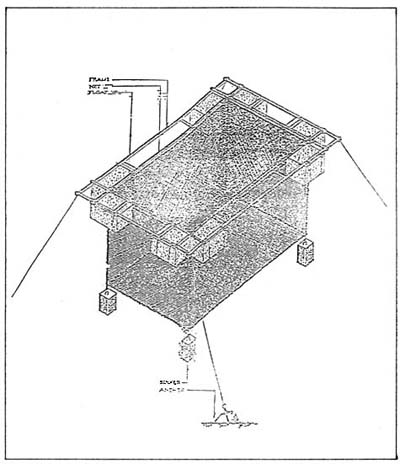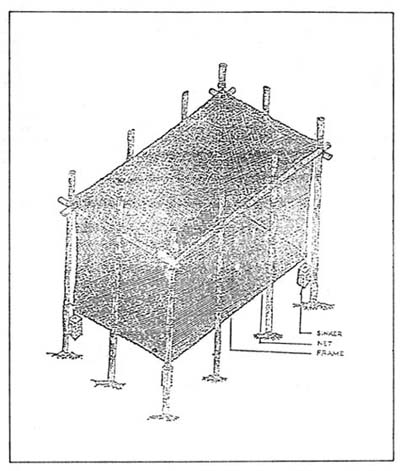Wichian Yongprapat 1
I. Introduction
Lates calcarifer (Bloch), commonly called seabass or giant sea perch, has
been cultured in Southeast Asia for more than ten years, in marine,
brackish, and fresh waters. Cage culture of seabass in coastal waters is
popular in Thailand, Hong Kong, Taiwan, Malaysia, Singapore and Indonesia.
The method is simple and highly profitable when compared to pond culture.
Thus, cage culture of seabass has expanded rapidly in the last five years
particularly in Thailand. However, the major constraints to rapid
expansion, are disease outbreaks during the culture period and insufficient
supply of trash fish.
Despite some imperfections, the basic technique of seabass cage culture has
been developed and now considered economically viable.
II. Site selection for fish culture
The criteria for selecting a suitable site for seabass cage culture are the following:
Water salinity. This should range from 10–31 ppt.
Tide and water depth. Water depth should be more than 2–3 meters. This is due to the standard size of the cages which are 5 m × 5 m and 2 m deep. The tidal range should allow the water depth to be at least 2 meters at the low water of spring tide.
Current and waves. The area should be protected from strong winds, waves and current. An ideal area would be in protected bays, sheltered coves and inland sea.
Water quality. The site should be relatively free from domestic, industrial and agricultural waste and other environmental hazards.
Water circulation. The site should have an adequate water circulation to improve on poor water quality that could occur at certain times due to the decomposition of waste material, which often accumulate under the netcages.
The minimum ranges permitted for some water quality parameters for cage culture of seabass, are shown in Table 1.
| Parameters | Ranges |
| pH | 7.5 – 8.3 |
| Dissolved Oxygen | 4.0 – 8.0 mg/l |
| Water salinity | 10 – 31 ppt |
| Water temperature | 26 – 32 °C |
| Ammonia - nitrogen | less than 0.02 mg/l |
| Hydrogen sulfide | none |
III. Nursery
Seabass fry and fingerlings are reared in concrete tanks up to the size of
2.5 cm. After that, they are transferred to nylon net cages until they
attain 25 cm. This size is reached in 2 to 3 months.
The most convenient cage design is a rectangular cage made of synthetic
netting attached to wooden, GI pipe or bamboo frames. It is either (a)
kept afloat by styrofoam, plastic carboy or (b) stationary by fastening to
a wooden or bamboo pole at each corner. The size of cage varies from 0.9 ×
2.0 m and a depth of 0.9 m to 1.0 × 2.0 meters and a depth of 1.0 meter
(Fig. 1). The mesh size of the nylon net is 1.0 mm. However, after a
month of nursing, they can be transferred to netcages with a mesh size of
0.5 cm. This allows water to pass through the cages more freely.
The stocking density is approximately 1,000 fingerlings per cage. Grading
of fingerlings is done at least once a week during the nursery period.
Stocking is done separately for each size group. This tends to minimize
losses from cannibalism. Fingerlings of 2.5–5 cm are fed daily with ground
trash fish at 8–10 % of body weight, 4 to 5 times a day.
The netcages should be checked daily to ensure that they are not damaged by
crabs or clogged with fouling organisms. The cages are cleaned every other
day by soft brushing in order to allow water circulation in the cage.
The survival rate for the nursery period is usually 50–80 % . This depends
on feeding, aquatic environmental conditions, and on the experience of the
fish farmer.
IV. Rearing market-size fish
Fish are reared from juvenile to marketable size for another 5 to 20 months. The marketable size requirements of the seabass are between 700–900 g and 2,000–3,000 g. However, the size between 700–900 g is highly demanded by the local market and consumers in neighboring countries.

Figure 1. Nylon netcage for nursing seabass fingerlings.
There are two types of cages used in seabass culture in Thailand:
a. Floating Cages
The netcages are hung from GI pipe, wooden or bamboo frames. The most convenient dimension for a cage is that of a rectangle and a volume of 50 m3 (5.5m × 6m × 2m). The cage unit is stabilized with concrete weights at each bottom corner (Fig. 2). The cage unit is anchored to the bottom. The cages may rock a little in strong wind and current. Floating cages can be set on coastal waters where tidal fluctuation is ample.
b. Stationary Cages
This type of cage is fastened to wooden poles at its four corners
(Fig. 3). Stationary cages are usually set in shallow bays where
the tidal fluctuation is narrow.
The mesh size of the nylon nets depends on the size of fish.
Fingerlings are transferred to a nylon net (mesh size of 2.0 cm) for
about 2 months, then moved to a cage net of 4.0 cm mesh size until
harvest.
Stocking density for marketable fish culture varies from 100–300 m3
(Table 3), depending on water quality and the environmental
conditions of the culture site. Floating cages can be stocked with
more than stationary cages. This is because floating cages are
usually set in sites with better aquatic environmental condition
such as deeper water, narrower fluctuation of water salinity, more
water circulation and distance from sources of pollution.
Table 2. Growth of seabass at different stocking densities in cages (after Sakares, 1986).
| Culture period (days & months) | Stocking density | ||||
| 100/m3 | 150/m3 | 200/m3 | 250/m3 | 300/m3 | |
| 30 (1m) | 119.7 g | 115.6 g | 116.7 g | 117.7 g | 117.8 g |
| 60 (2m) | 222.7 g | 218.4 g | 208.6 g | 212.4 g | 208.1 g |
| 90 (3m) | 309.0 g | 306.4 g | 294.4 g | 293.1 g | 285.1 g |
| 120 (4m) | 380.0 g | 361.2 g | 368.0 g | 368.0 g | 345.7 g |
| 150 (5m) | 448.0 g | 420.5 g | 418.0 g | 410.9 g | 379.4 g |
| 180 (6m) | 523.4 g | 495.8 g | 463.3 g | 449.9 g | 436.5 g |
| 210 (7m) | 573.3 g | 569.9 g | 551.4 g | 527.9 g | 505.4 g |

Figure 2. Floating netcage.

Figure 3. Stationary netcage.
Trash fish is the main feed for cultured seabass. Trash fish should be
fresh and clean. Trash fish used in Thailand are sardines and other small
marine fish. The trash fish is chopped and fed twice a day, in the morning
and afternoon. The size must be suitable for the size of the mouth of the
fish. The farmers give the feed slowly and watch the fish. Feeding is
stopped when the fish no longer come up to the surface as it indicates that
the amount of feed given is enough.
Food conversion rates of seabass culture in Thailand decreases with
stocking density. It ranges from 3–10. It also depends on the quality and
quantity of trash fish. Normally, seabass can grow at an average weight
increase of 1 kg/yr.
Survival rates to marketable fish are around 80–95 % in normal culture
conditions.
The cages are checked every month or once in two months to ensure that they
are not damaged by fouling organisms, crabs or flotsam. The cages are
cleaned or changed every month. Therefore, fish farmers usually have spare
nylon netcages. Changing cages also allows the farmer to check on the
number and health of fish.
V. Financial Analysis for Small-Scale Fish Culture
Types of cages can be divided into two:
standard, which is made of GI pipe frames, and
ordinary, which makes use of wooden frames.
The total cost is 12,700 baht per cage of the standard type, and 4,400 baht
per cage of the ordinary type. The cost per year is 4,051 for the standard
type and 1,575 baht for the ordinary type (Tables 3 and 4).
A floating cage can culture 1,000 fish. The cost would be about 14,675 to
17,151 baht. The production or yield is about 350 kg/yr.
Thus, the fish farmer can realise a benefit of about 3,849 to 6,325 baht
per cage per year (Table 5).
Table 3. Cost of investment for standard floating cages (5 × 5 × 2m).
| Material | No. | Duration (yr) | Total cost (Baht) | Cost per year (Baht) |
| 1. GI pipe frame | 4 | 5–8 | 2,800 | 623 |
| 2. Nursing net | 3 | 1–2 | 900 | 600 |
| 3. Marketable net | ||||
3.1 mesh size 2.0 cm | 1 | 3–5 | 3,600 | 1,028 |
3.2 mesh size 4.0 cm | 1 | 3–5 | 2,000 | 500 |
| 4. Styrofoam drum | 1 | 3–5 | 2,000 | 500 |
| 5. Other materials | - | - | 1,000 | 500 |
| Total | 12,700 | 4,051 |
Table 4. Cost of investment for ordinary floating cages (5 × 5 × 2m).
| Material | No. | Duration (yr) | Total cost (Baht) | Cost per year (Baht) |
| 1. Wooden frames | 4 | 2 | 800 | 400 |
| 2. Styrofoam drum | 4 | 2–4 | 1,200 | 400 |
| 3. Nursing net | 1 | 3–5 | 1,000 | 250 |
| 4. Marketable net | 1 | 3–5 | 900 | 225 |
| 5. Other material | - | - | 500 | 300 |
| Total | 4,400 | 1,575 |
| Standard type | Ordinary type | |
| 1. Cages | 4,051 | 1,575 |
| 2. Fingerlings | 2,500 | 2,500 |
| 3. Feed | 7,000 | 7,000 |
| 4. Labour | 3,600 | 3,600 |
| Total | 17,151 | 14,675 |
| 5. Yield (kg) | 350 | 350 |
| 6. Income ฿ | 21,000 | 21,000 |
| 7. Benefit ฿ | 3,849 | 6,325 |
APPENDIX 1.
Coastal aquaculture in Thailand, 1985 (Thai Fishery census of Thailand).
| Type of culture | No. of families | Area (rai)1 | Percent by area2 |
| 1. Fish culture | 1,579 | 3,698 | 1.58 |
1.1 pond culture | 289 | 3,418 | 1.46 |
1.2 cage culture | 1,290 | 2,802 | 0.12 |
| 2. Shrimp culture | 4,480 | 217,574 | 92.98 |
| 3. Crab culture | 122 | 369 | 0.16 |
| 4. Oyster culture | 1,170 | 3,924 | 1.67 |
| 5. Mussel culture | 257 | 1,456 | 0.62 |
| 6. Cockle culture | 112 | 6,956 | 2.97 |
| 7. Horse mussel culture | 6 | 13 | 0.005 |
| 8. Others | 3 | 3 | 0.001 |
| Total | 7,720 | 233,993 | 100.0 |
1 1 Rai = 1,600 m2
2 280 Rai = 17,920 caged (5 × 5 × 2m)
APPENDIX 2.
| Zone | No of families | Percent |
| Eastern part | 94 | 5.95 |
| Central part | 222 | 7.03 |
| Southern part | 1,374 | 87.02 |
| Total | 1,690 | 100.00 |
APPENDIX 3.
Production of fish culture, 1981–1985 in MT (Thai Fisheries Statistics).
| Species | 1981 | 1982 | 1983 | 1984 | 1985 |
| Seabass | 215 | 145 | 1,059 | 473 | 512 |
| Grouper | - | - | 176 | 149 | 117 |
| Mullet | - | 1 | - | 4 | - |
| Total | 215 | 146 | 1,235 | 626 | 629 |
APPENDIX 4.
| Type of culture | No of family | Without sale | With sale | Provincial area | Other provinces | Not reported | |||||
| Sale to consumer | Sale to retailer | Sale to middleman | Sale to fish processor | Sale to Bangkok | Sale to3 others | Sale to fish processor | |||||
| Fish culture | |||||||||||
| 1 pond culture | 289 | 49 | 240 | 13 | 33 | 118 | - | 15 | 61 | - | - |
| 2 cage culture | 1,290 | 156 | 1,127 | 67 | 159 | 825 | 1 | 2 | 72 | 1 | 7 |
| Total | 1,579 | 205 | 1,367 | 80 | 192 | 943 | 1 | 17 | 133 | 1 | 7 |
3 = Sale to provinces other than Bangkok
APPENDIX 5.
| Size | Disease (%) | Case of Disease | Mortality | Treatment |
| 3–8 days (0.5 cm) | Gas-bubble disease | - | 90–100 | Formalin 25–30 ppm 24 hrs. |
| 10–20 days (0.5–1.5cm) | Black body | - | 50 | Formalin 100–200 ppm 15–20 min and Tetracycline 25 ppm. 24 hrs. |
| 2.5–8 cm | Marine white-spot disease | Cryptocaryon sp. | 10–100 | Formalin 30 ppm. 30 mins. |
| 1.5 inches | Kidney disease | Vibrio sp. | 5–100 | Ampicillin 50–100 ppm. 5–7 days |
| 3 inches | Columnaris disease | Flixibacter columnaris | 60 | Acriflavine 3ppm. 3 days or NaCI 3–5% 5 mine 3 days mined feed |
| 3 inches | Finrot and Tail rot | Aeromonas hydrophilia A. punctata | 5 | Tetracycline 25 mg/kg Fish or Intect 6 mg/kg Fish |
| 4–7 inches | Hymphocystis | DNA Virus | - | - |
APPENDIX 6.
| Kind of Parasite | Attacked Location | Mortality (%) | Treatment |
| Protozoa | |||
Blastodimidae | Gill | - | formalin 250 ppm 30 min or formalin 50 ppm. 24 hrs. 3 – 4 times/2 days |
Epistylis sp. | Gill, body, eye, fin | 5–80 | |
Henneguya sp. | Gill | 5–80 | |
Opistonectus sp. | Gill, body skin | 5–80 | |
Trchotina sp. | Gill, body skin | 50–100 | |
| Helminthes | |||
Diplectanum latesi | Gill | 2–5% everyday | |
| Crustacean | |||
Aega spp. | Gill | 5 | Formalin 50 ppm. 3–6 hrs. or dipterex 0.25–0.5 ppm. |
Gnathia sp. | Gill, mouth cavity | more than 20% | |
REFERENCES
Department of Fisheries. 1987. Fisheries Record of Thailand 1985. No 4/1987. Fish. Stat. Subdivision, Dept of Fish. 94 p.
Kungvankij, P. et. al. 1986. Biology and Culture of Seabass (Lates calcarifer), NACA Training Manual Series No. 3, NACA/RLCP, Bangkok, 70 p.
National Statistical Office and Department of Fisheries. 1987 and 1985 Marine fishery census of Thailand. 329p.
Sakaras, W. 1986 Optimum stocking density of seabass (Lates calcarifer) culture in cages. ACIAR Proceedings No 20. 172–175pp. Canberra Printing Co. Melbourne.
Sirikul, B. 1982. Aquaculture for seabass in Thailand, SCS/GEN/82/39, UNDP, 9–10p.
Sungkasem, P. 1982. The economics of seabass production, SCS/GEN/82/39, UNDP, 53–57p.
Tookwinas, S. et. al. 1987. Cage culture of brackishwater fish in Satul Province. Technical Paper, Brackishwater Fisheries Division, Dept. of Fisheries. 30 p.
Tookwinas, S. 1985. Consideration aspects for coastal aquaculture survey. Thai Fisheries Gazette. 38(4): 243–249.